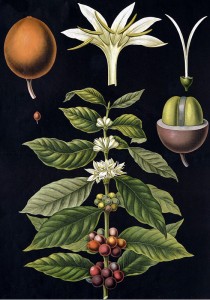 There are a great number of coffee plants around the world, and that number is steadily increasing. Over the last ten years, more than a dozen new types of coffee plants have been discovered, with various properties. As late as 2009, two types of plants from Cameroon were discovered and named, the Coffea anthonyi and the Coffea charrieriana.
There are a great number of coffee plants around the world, and that number is steadily increasing. Over the last ten years, more than a dozen new types of coffee plants have been discovered, with various properties. As late as 2009, two types of plants from Cameroon were discovered and named, the Coffea anthonyi and the Coffea charrieriana.
But the most common of all coffee plants is the Coffea arabica, which produces about 80% of the beans for our daily cup of coffee. The arabica was originally found in the Arabian Peninsula, but is today grown all over the world. It takes about 7 years for the arabica plant to mature, and a plant usually produces around 1,5-2 pounds of coffee beans a year.
The Coffea canephora, which produces the robusta beans, is easier to care for than the arabica. It produces more coffee, grows on lower altitudes than the arabica and is more resistant to various diseases, which makes the robusta bean cheaper to produce. The robusta bean has nearly twice the caffeine as the arabica. Its main use is in cuvées, amongst others to create the crema in espresso coffee.
It’s important to keep and care for a variety of coffee plants because coffee plants are sensitive to climate change and diseases. Around 1870, coffee rust was discovered in Sri Lanka, which eventually spread all over the world: west-Africa around 1950, Brasil 1970.


